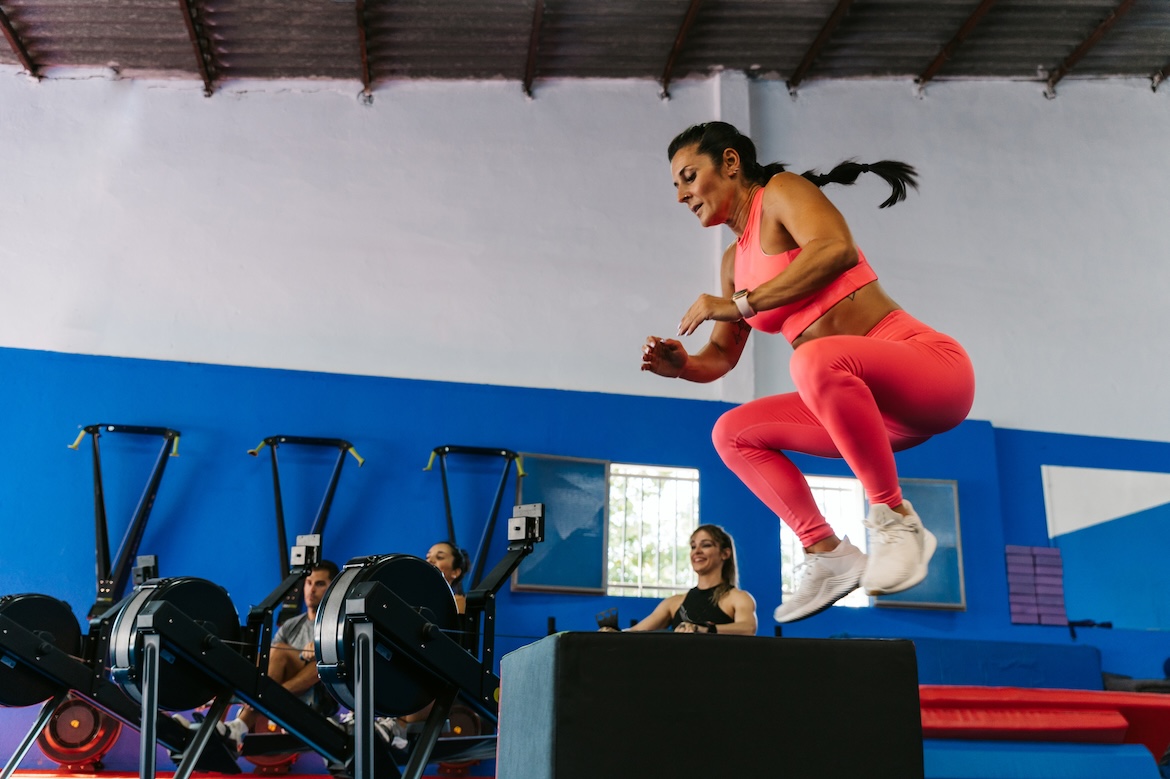Imagine reaching the age of 100 but feeling unwell for the last four decades—that’s certainly not an ideal way to age. If your goal is to maintain fitness throughout your life and embrace aging gracefully, incorporating box jumps into your routine could be the solution. This dynamic exercise, which involves jumping from the ground onto a sturdy elevated surface, such as a plyometric box, not only enhances strength and explosive power but also fosters agility and resilience as you grow older.
Are you ready to leap toward a longer, healthier life? In this guide, we’ll explore how box jumps can bolster your long-term health, improve your balance, and potentially slow the aging process.
How to Perform Box Jumps with Perfect Form
- Stand about a foot away from a box or suitable elevated surface, feet hip-width apart.
- Bend your knees and push your hips back while swinging your arms behind you.
- Explode upward from the balls of your feet, swinging your arms forward to assist your jump.
- Land softly on the box in a mini-squat position, allowing your knees and hips to bend slightly to absorb the impact.
- Carefully step down from the box onto the floor; this completes one repetition.
Your fitness level and the height of the box you choose will determine how many repetitions you can perform with proper form. Grayson Wickham, DPT, CSCS, a physical therapist and founder of Movement Vault, suggests starting with 3 to 5 sets of 10 to 15 repetitions. Box jumps can complement your leg day, full-body workouts, or HIIT sessions, making them a fantastic choice to elevate your heart rate.
Five Ways Box Jumps Promote Healthy Aging
Aging gracefully doesn’t require secret formulas; a combination of healthy habits—such as consuming nutritious foods, getting quality sleep, managing stress, and exercising regularly—constitutes the foundation of wellbeing. While various types of exercise contribute to long-term health, box jumps stand out as a key player. Here’s how they can help maintain your strength and agility over the years.
1. Strengthens Bones
As time passes, your bones naturally lose mass and density, particularly during the postmenopausal phase. Osteoporosis is a condition that affects 10 million Americans, increasing the risk of fractures, according to the National Institutes of Health (NIH).
Weight-bearing exercises apply stress to your body’s connective tissues, stimulating an increase in bone density over time.
The silver lining? You have the power to slow down or prevent bone loss through weight-bearing exercises. These activities, including box jumps, create stress on your bones, encouraging them to become denser and stronger. The force absorbed during box jumps not only enhances muscle strength but also improves your lower body control and stability, according to Wickham.
2. Increases Explosive Power
Have you ever had to sprint to catch public transport? That crucial burst of energy is what we refer to as “relative explosive power.” Regardless of your age, having the ability to move with speed while reducing the risk of injury is essential.
To maintain agility into your later years, box jumps should be in your fitness arsenal. The plyometric nature of this exercise conditions your muscles for rapid acceleration and deceleration, leading to improved explosive power. Additionally, this training method enhances skeletal muscle performance along with cardiovascular endurance—vital components for a long, fulfilling life.
3. Supports Mitochondrial Health
Constant fatigue? Your mitochondria could use some TLC. These microscopic powerhouses in your cells dictate your energy levels. With age, mitochondrial quality can decline, leading to decreased energy. However, engaging in exercises like weightlifting and box jumps can significantly enhance mitochondrial function.
Box jumps stimulate the generation of new mitochondria and improve their efficiency in producing ATP—your muscle’s primary energy source, helping you experience better endurance and quicker recovery times between workouts.
4. Stimulates Stem Cell Proliferation
Repairing damage is a natural part of life. Efficiently replacing damaged cells and tissues is crucial for healthy aging, and stem cells play a pivotal role in this process.
Engaging in exercises such as box jumps can boost your body’s stem cell production. The microscopic muscle damage caused during box jumps triggers an inflammatory response that activates satellite cells (your body’s muscle-repairing stem cells). Consequentially, these cells either repair damaged muscle or facilitate the development of new muscle fibers. Box jumps also encourage the release of insulin-like growth factor-1 (IGF-1), a significant hormone related to muscle recovery and cellular activation.
5. Enhances Balance and Coordination
To maintain stability and independence as you age, it’s wise to prioritize balance training now. Although balance might seem trivial in youth, it can significantly impact safety down the road. According to the Centers for Disease Control and Prevention, one in four older adults experiences a fall each year, with serious injuries occurring in 20% of those incidents.
Box jumps cultivate strength and stability in essential areas such as the core, hips, knees, and ankles, all vital for maintaining balance and coordination. The simultaneous jumping and landing challenges the control you have over each joint, enhancing your overall stability and reducing the likelihood of falls.
Discover more from Marki Mugan
Subscribe to get the latest posts sent to your email.









